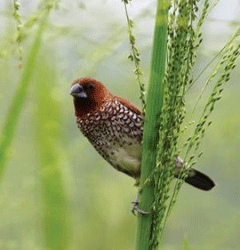Emerging Science Note/Social Birds
Air Date: Week of November 3, 2006

The spice finch is also referred to as "nutmeg mannikin" and was one of the species used in the UC/San Diego study. (Courtesy of Dave Behrens)
Scientists look to birds to help explain why some people are social creatures and others prefer to be alone.
Transcript
[SCIENCE THEME]
PERCY: Flashback to high school. Were you part of a social group, or at least did you desperately want to be? Or maybe you just preferred to be alone. Scientists at the University of California, San Diego are studying birds to better understand why certain people flock together and others prefer the life of a loner. They found the secret lies deep in our brains.
The researchers traveled to South Africa to find the perfect subjects: a group of closely related waxbills and finches that are similar in all ways but one - some species are territorial, and live in colonies of about 100, and the rest are solitary, living alone or with a monogamous mate.

The spice finch is also referred to as "nutmeg mannikin" and was one of the species used in the UC/San Diego study. (Courtesy of Dave Behrens)
The scientists believe vasotocin plays a similar role in humans. Though they don’t know why some of us have more neuron activity than others, they hope these findings could one day help alleviate shyness and lead to a cure for social anxiety disorder.
But they warn we are a long way from being able turn a misanthrope into a party-going socialite.
That’s this week’s note on emerging science. I’m Jennifer Percy.
Links
Living on Earth wants to hear from you!
Living on Earth
62 Calef Highway, Suite 212
Lee, NH 03861
Telephone: 617-287-4121
E-mail: comments@loe.org
Newsletter [Click here]
Donate to Living on Earth!
Living on Earth is an independent media program and relies entirely on contributions from listeners and institutions supporting public service. Please donate now to preserve an independent environmental voice.
NewsletterLiving on Earth offers a weekly delivery of the show's rundown to your mailbox. Sign up for our newsletter today!
 Sailors For The Sea: Be the change you want to sea.
Sailors For The Sea: Be the change you want to sea.
 The Grantham Foundation for the Protection of the Environment: Committed to protecting and improving the health of the global environment.
The Grantham Foundation for the Protection of the Environment: Committed to protecting and improving the health of the global environment.
 Contribute to Living on Earth and receive, as our gift to you, an archival print of one of Mark Seth Lender's extraordinary wildlife photographs. Follow the link to see Mark's current collection of photographs.
Contribute to Living on Earth and receive, as our gift to you, an archival print of one of Mark Seth Lender's extraordinary wildlife photographs. Follow the link to see Mark's current collection of photographs.
 Buy a signed copy of Mark Seth Lender's book Smeagull the Seagull & support Living on Earth
Buy a signed copy of Mark Seth Lender's book Smeagull the Seagull & support Living on Earth

